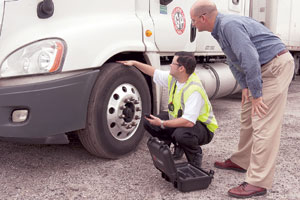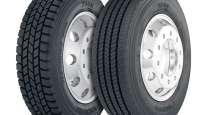In Typical Roadside Tire Emergencies, It’s Often Tire Makers to the Rescue

This story appears in the Aug. 15 print edition of Transport Topics.
Roadside tire emergencies typically strike without warning, despite the best-laid preventive maintenance programs of fleet and maintenance managers.
With hazards lurking along every mile of roadway, there is the possibility the next call they receive could be about a driver stuck along the roadside. However, by becoming familiar with roadside tire emergency services, fleet and maintenance managers can keep such delays to a minimum so their trucks are quickly back on the road and earning money.
The nation’s largest tire makers offer extensive help, coast-to-coast, 24 hours a day.
For example, Goodyear’s Fleet HQ Emergency Roadside Service includes 2,300 dealers that sell Goodyear tires, and about 800 of them are part of its Commercial Tire and Service Network, said Jose Martinez, Goodyear’s digital and business solutions manager.
“Whenever we receive a call, if the closest dealer is a CTSN dealer, we are going to try and dispatch that dealer, because one of the requirements to be a CTSN dealer is they have a night cage inventory,” he said. “One of the technicians is always on call, so the dealer might be closed, but in this night cage, they are required to carry the most popular sizes of tires someone might need in a roadside tire emergency.”
Other tire makers also offer roadside tire emergency services. The Bridgestone Everywhere Network has 2,500 service providers, and Michelin offers ONCall 2.0, using more than 700 commercial dealers in North America.
Cooper Tire & Rubber Co. got into the business less than a year ago, launching its Roadmaster Fleet Service Network. Gary Schroeder, director of commercial vehicle and global OEM Roadmaster sales, said Cooper looks for dealers with a broad service and tire product offering. “That means offering products and services customers demand in order to keep them on the road and reduce downtime,” Schroeder said.
If fleet managers think a roadside tire emergency will result in their trucks sitting for much of the day, that’s usually not the case. A typical turnaround time for these services is just more than two hours.
Michelin’s average roll time, or the time from when contacted about a truck with a problem until it is back up and running, is 115 minutes, said Adam Murphy, vice president of marketing at Michelin Americas Truck Tires.
“The benefit for the fleet is, No. 1, across North America over 700 Michelin commercial service network points are audited to the same standard,” he added. “Historically, it’s been a roll of the dice for a fleet: Do they have a relationship with the service provider in whatever area they happen to have the event occur? But with the Michelin Commercial Service Network, it’s the same standard.”
When a fleet manager needs emergency roadside tire service, the first inclination probably is to call a central number for help. But that’s no longer the only way to connect. Goodyear and Bridgestone, for instance, offer cellphone apps that allow truckers or fleets to connect quickly with tire makers for help.
The Goodyear Road Service app “instantly connects” truck drivers who need help to the company’s Fleet HQ Emergency Roadside Service call agents. They, in turn, will dispatch a tire technician from a CTSN dealer or Goodyear’s Commercial Tire and Service Center, Martinez said.
Goodyear also offers the SmartTech app, which Martinez said expedites the service call process by eliminating time-consuming steps and gives fleet managers visibility into what is happening during the calls. For instance, it offers fleets pictures of the incident that can be accessed online.
“What this app has done is, all of that information taken by the agent is automatically transferred in real time to the technician’s phone and eliminates the need [for the tech] to take notes,” he said. This is especially helpful when tire technicians are awakened in the middle of the night to respond to breakdowns. The app also transfers over notes for fleets that have certain requirements in their national contracts, Martinez said.
Bridgestone offers the Everywhere Network, an app that also can be accessed online. The app has an interactive map featuring dealer and truck stop locations for Bridgestone and Firestone commercial tires, as well as Bandag retreads. Service providers can be found based on GPS location or other location that is entered.
While Michelin doesn’t have a phone app for roadside tire emergencies, it offers live tracking of service events, allowing maintenance and other personnel to monitor progress and “fix pics,” which are a visual verification of the service technician’s work.
Meanwhile, some fleet managers may be disappointed with the support they receive from the company that makes the tires they use. Do they still have to use that company for emergency roadside service? No, said Michelin’s Murphy.
“We actually have fleets that use us as a service provider who do not buy our tires,” he said. The other benefit is Michelin’s national account program, Murphy said. “No matter where they are in the country, they’re going to pay the same price for the tire.”
Most manufacturers offering emergency roadside tire service aren’t new to the game and have learned what works for customers. For example, Goodyear’s Martinez said its operation is all in-house. Team leaders have at least five years of experience, with some having 15 to 20 years in the tire business.
“Our training process is also very vigorous, and we monitor all of our calls, he said. Whenever we get a complaint from the fleet, we’ll review those,” he said. “Everyone is upping their game, and so are we.”
Murphy said Michelin’s goal is to “put ourselves out of business with ONCall 2.0” by working more closely with fleets and looking at their tires to help them avoid roadside problems caused by low tire pressure, shallow tread depth and overall visual inspections.
Although roadside tire emergencies are a fact of life, fleet managers can reduce the number of incidents.
“Proper tire use and maintenance go head in hand with achieving the best tire performance but are often overlooked by commercial truck fleets,” said Jared Williams, manager of fleet and OE marketing programs at Bridgestone. This includes performing frequent tire inspections, maintaining proper tire inflation pressures and selecting the right tire for the job.
“Making proactive service decisions will keep fleets moving forward with minimal downtime,” Williams said.




